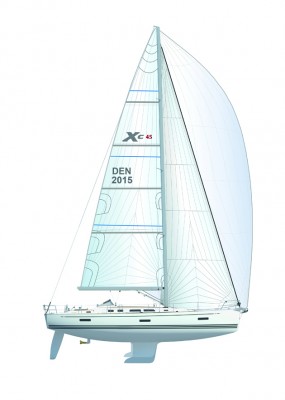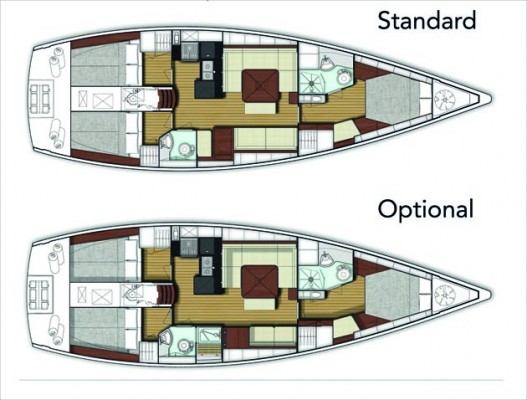Toby Hodges loved the Xc45 first time around. Does this new Next Generation version add anything to the original cruising package?
Xc45 Next Generation boat test – a sailors’ boat
Are rebranded ‘Mk II’ models just an elaborate marketing exercise? Occasionally, yes. But a number of well-respected boatbuilders adopt the practice, including Hallberg-Rassy, Oyster and Discovery – in fact, HR is on to MkIII with some boats.
Sometimes the new model is given a different name, as with the Discovery 58 that replaces the 57 or the new incarnations of Oyster’s 46 and 54, now badged the 475 and 545.
The point to consider with these popular bluewater cruisers is that there is little to be improved upon in terms of hull design that justifies the cost of building a new mould. It is more a case of breathing upon an established product to make it more practical at sea. And of using the lessons learnt from the first batch of owners to improve its liveability.
But are there enough new features on one of these rebadged luxury builds to get excited about? Can tampering actually spoil a well-established product? That was my biggest fear when invited to test X-Yachts’ new ‘Next Generation’ version of its Xc45.
Right first time
Seven years ago we travelled to Denmark to test the Xc45, the first new cruising yacht from X-Yachts. I found then that, on its first attempt, the Danish company that had its heritage rooted in racing designs had managed to create an exemplary cruising yacht. She had a shape that provided a kindly motion and yet plenty of volume, with elegant looks and was rewarding on the helm too.
I was smitten, and I was not alone. The Xc45 went on to win a European Yacht of the Year award, and a full range of cruising Xs were born. Since then an impressive 250 of these have been sold and between them have sailed around one million miles.
So why mess with such a successful design? X-Yachts has decided to go through its Xc range and update it with modifications, starting with the Xc45. ‘Next Generation’ is its slogan for these Mk II versions.
On boarding this new Xc45, I thought she seemed compact, low and narrow compared with today’s shapes – but these are not necessarily criticisms. Indeed it’s rare these days to be able to board a yacht of this size from the dock without needing steps.
Time is cruel though. Park the original X alongside a fleet of modern designs at a boat show and you’ll notice how some features have moved on. So tweaks to this Next Generation model have brought the Xc45 up to date both aesthetically and practically.
Larger hull windows immediately make the revised Xc45 look more contemporary – and they provide more light below to help freshen up a calming and fairly traditional Scandinavian-style interior.
Subtle differences
X Yachts surveyed as many Xc owners as possible about what they would change. These owners are typically couples in their sixties, occasionally sailing with friends or grown-up children. A percentage come from a racing or performance background, hence the desire for a yacht that provides some sailing fulfilment.
The improvements these owners suggested were minor details rather than major changes. It is the smaller practical things that tend to make a big difference when living aboard.
For instance, several reported that there was not enough bin space on the original design. So the galley sink on the new model is located more centrally to create large bins below the worksurface inboard.
There is a lot more stowage and optional stowage throughout. Internal storage space was obviously found wanting on the original design, in fact, as X has now used every nook and cranny possible as potential stowage space. Lockers and drawers now have self-locking, soft-closing mechanisms and the drawers are mounted on hidden runners so they can be pulled out fully.
Another improvement is to be found in the elegant counter transom. Originally X had designed a clever liferaft launching system into this, but it used valuable locker space and resulted in a small bathing platform. Liferaft stowage is now below the cockpit sole, creating a much larger, more practical platform and more stowage space aft in what was the liferaft locker. The liferaft cannot now be launched so efficiently, however, and the quarter lockers remain difficult to access.
The Xc45 has been adapted behind the scenes. X found weight savings throughout the boat in the joiner work and construction (225kg), adding this as ballast into the keel for greater stability. The stainless steel arch that supported the mainsheet has been replaced with carbon fibre, for example, saving weight and space by opening up the headroom below.
Aft cockpit appeal
We originally published a full report on the performance of the Xc45 from our Denmark test in lively conditions. As little has changed with the hull design, it was pointless to repeat the process in terms of performance evaluation. But a Solent sailing trial on the Xc45 Next Generation model, held in a gusty breeze ranging from 8-18 knots, did serve to remind me how rewarding this yacht is at sea. She is a sleek cruiser, slippery yet stable, with a soft, quiet, well-mannered motion.
Average boat length has grown significantly since the original Xc45 was launched. But what stood out for me is how ideal a size she remains for a couple or small family. By this
I mean that she is easy to manoeuvre and that the loads are manageable. She is only around 14 tonnes on the water, hence the sheets can be relatively narrow in diameter (10-12mm), which is easy to handle. The cockpit is deep and well-protected from the elements, yet compact in size, and with a comparatively narrow beam it is easy to move from one wheel to the other during a tack.
The true pleasure is reserved for helming as this is a real sailor’s yacht. Some bluewater cruisers make you want to engage the autopilot after a few minutes on the helm. The X is the opposite – you won’t want to leave the wheel.
Helming from the quarters provides more pleasure than a centre-cockpit layout because the steering linkage is more direct and the sight lines are clearer. The Xc45 has good balance and enough feedback to feel small gusts yet remind you of her medium displacement. The electric mainsheet winches make handling the main a doddle from the helm, but the jib can’t be trimmed from here unless it is swapped with the mainsheet lead.
The enjoyment on the helm is accentuated further under asymmetric spinnaker – you can feel the wheel load up when the angles are pushed, and she has noticeable acceleration.
The creditable performance of the Xc45 is thanks to a design that strictly governs the allocation of weight, and a build that creates a very stiff structure. All tanks are mounted centrally below the sole for improved balance and reduced pitching. The deep immersed sections provide the interior volume needed for this tankage, plus stowage space for other essential cruising equipment.
The Xc45 uses the company’s tried and tested internal steel frame to absorb loads from the mast and encapsulated keel. Two longitudinal girders take the keel load and spread it across three main crossovers.
The words of X-Yachts designer/founder Niels Jeppesen still ring in my ears from our original test: “We design our boats like this so the keel is able to hit a rock at full hull speed.”
Creating space
Little has changed down below, but the Xc45 Next Generation comes across as smart and fresh. She has a practical layout at sea. Grabrails run along both sides of the interior and all surfaces are fiddled, so she feels secure to walk through when heeled.
X-Yachts increasingly uses white vinyl on headlinings and bulkheads in an effort to keep its interiors light and provide contrast to the traditional teak veneer. There is some neat joiner work detailing throughout – for instance, the veneer on the saloon table is set in quarters so the grain runs in four directions.
The only change to the three-cabin layout is the option for a separate shower in the aft heads instead of a permanent chart table. Surprisingly, no owners have yet chosen the former option, indicative perhaps of the traditional client base. Owners would rather crew suffer a slightly cramped heads than sacrifice a proper chart table!
The galley feels roomy and now has extra stowage space. Gone is the vertical grab bar that I appreciated for the bracing it provided by the companionway, however.
Specifications
LOA 13.86m/45ft 6in
LWL 12.76m/41ft 10in
Beam (max) 4.32m/14ft 2in
Draught 2.20m/7ft 3in
Disp (lightship) 13,220kg/29,145lb
Ballast 5,740kg/12,654lb
Sail area (100% foretriangle) 113m2/1,218ft2
Berths 6
Engine 80hp Yanmar saildrive
Water 610lt/134gal
Fuel 440lt/97gal
Sail area:disp 20.6
Disp:LWL 177
Price ex VAT: €398,000 (£276,090)
Designed by: Niels Jeppesen/X-Yachts Design
Conclusion
The Xc45 was my ideal cruising yacht in 2007. And in truth, very little has changed with this Next Generation model. So it could be argued that the new branding is more a means of bringing the Xcs back into the public eye.
But a more positive line to take is that the original product was complete enough not to warrant large changes, and that this freshened-up version simply serves to remind us that she remains a very current, enjoyable design, one with staying power.
The Xc45 strikes a deft balance between comfort, performance, security and looks. She is a very user-friendly, inviting boat to sail, neither daunting in size nor heavy enough to exert worrying loads on the deck gear. And, for a displacement cruiser, the Xc45 really is a remarkably pleasant yacht to helm.
Could X-Yachts do more? Doubtful. The Xc45 still stands out as the sailor’s choice of production-built bluewater cruiser at this size. She is truly designed by sailors for sailors – and this is the focal element that is just as applicable today as it was when the original model was launched.














